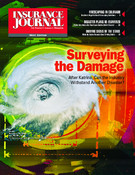If Congress Changes Regulation, Impact Would be Big … But That’s a Big ‘If’
While underwriting cycles and the dynamics of distribution are certain to shape the surplus lines industry of 2010, a number of forecasters believe regulatory changes emanating from Washington might actually be the most powerful force in the years ahead.
“The surplus lines regulatory marketplace needs reform. How this plays out will be a huge factor for surplus lines,” claims David Blades, an analyst with A.M. Best, referring to the ongoing debate over how deeply the federal government should get involved in insurance regulation.
Certain federal moves could even “usurp” the role of surplus lines in some areas, according to Daniel Maher, executive director of the Excess Lines Association of New York.
If, in fact, Congress reconfigures insurance regulation, this would have major implications for surplus lines, most agree. But that’s a big “if.”
For several years, Washington policymakers have been talking about bringing national standards and increased uniformity to state regulation via the so-called SMART Act, as well as about giving insurers the option of a federal regulatory charter over the state scheme. They are still talking. Surplus lines observers doubt that these major changes that have inspired untold dollars in political contributions to lawmakers will be any more the reality in five years than they are today.
“GLB took 20 years,” recalled Dick Bouhan, executive director for National Association of Surplus Lines Offices. GLB is the Gramm-Leach-Bliley Act of 1999, which broke down walls between insurance and banks and also made it easier for excess and surplus brokers to obtain licenses in other states.
“At the end of the day, restructuring of the entire insurance regulation system is a big, big task that may take a while to do,” Bouhan said. “The public isn’t pushing this.”
Rick Lindsey, chief executive officer and president for Prime Insurance, is of a similar mind, believing that while federal regulation may eventually happen, it probably won’t for another 10 or 20 years. “States are going to maintain their individuality,” he said.
Marshall Kath, chief executive officer for Colemont Insurance Brokers, based in Dallas, is in the minority camp that envisions some form of the SMART Act being adopted within the next few years. Kath also thinks that Sarbanes Oxley and tougher European regulations will combine to raise the standards for all surplus lines carriers in the years ahead.
ELANY’s Maher does not expect significant regulatory movement by 2010. “Certainly an optional federal charter would have an effect on surplus lines. It would create competition and could usurp some of what surplus lines does,” Maher observed.
But, Maher adds, it’s unlikely to happen. “Look at TRIA, asbestos, GLB–you never get what you ask for. I don’t see a federal charter for property casualty. It’s driven by the life companies and banks.”
“Jump ball’ on SMART
As for more uniformity among state regulations as championed by the SMART Act, it “would be nice to see” but Maher senses that many states are reluctant to go along with freedom of policy forms and that many are not ready for complete rate deregulation. He terms it a “jump ball” at best whether the SMART Act gets anywhere by 2010. He thinks other matters, including fallout from Attorney General Eliot Spitzer’s probes, may thwart advancement.
A lot of what surplus lines regulation looks like in 2010 could depend on who is in the White House in 2010, and on whether Spitzer, who could be the Empire State’s governor and controlling that state’s insurance department, remains focused on insurance, insiders noted.
If, against the odds, Congress does move on insurance regulation by 2010, surplus lines brokers are pretty clear about what they would like to see happen. “If there is to be restructuring, we would hope the SMART Act approach of national standards would be the way to go,” NAPSLO’s Bouhan said.
In the brokers’ dream scenario, any federal revamp would embrace creation of a single payment system to end the nightmare of surplus lines tax allocation, which has actually been exacerbated by GLB.
Thanks to GLB, nearly every state now grants a nonresident surplus lines license. “It’s certainly allowed national brokers to get licensed nationally and even allowed smaller brokers to spread their wings,” noted Bouhan. But easier licensing has also meant that brokers must comply with a hodgepodge of regulations and tax rules in all the states where they hold nonresident licenses. A broker’s failure to follow applicable E&S laws can lead to fines, penalties and personal liability for client losses.
Surplus lines insiders are unanimous in their frustration with the mishmash of multi-state regulations and tax formulas. Mark Presser, assistant deputy superintendent at the New York State Insurance Department, agrees that surplus lines taxation is “really convoluted” but he questions whether it can be straightened out within the next five years. One obstacle is that insurance commissioners are not in charge; state revenue officials are.
In other surplus lines regulatory matters, it is likely that by 2010 the states will have adjusted the trust funding levels required of offshore companies, according to NYSID’s Presser.
Also, stamping offices for surplus lines, should be more streamlined and be better at working together by 2010, according to Maher. “Most stamping offices are moving to the next generation of systems to make it easier, simpler and faster to do business,” he said.
Topics Trends Agencies Legislation Excess Surplus
Was this article valuable?
Here are more articles you may enjoy.


 Florida Governor Signs Wind-Mitigation Funding Bills for Homes, Condos
Florida Governor Signs Wind-Mitigation Funding Bills for Homes, Condos  The Future Is Near for Self-Driving Trucks on US Roads
The Future Is Near for Self-Driving Trucks on US Roads  Here’s Why Experts Don’t Think Cloud Seeding Caused Dubai Flooding
Here’s Why Experts Don’t Think Cloud Seeding Caused Dubai Flooding  Two Montgomery Workers Charged with Insurance Fraud in Alabama
Two Montgomery Workers Charged with Insurance Fraud in Alabama 


